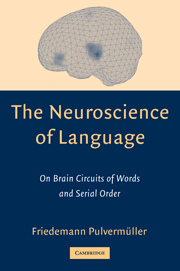Book contents
- Frontmatter
- Contents
- Preface
- The Neuroscience of Language
- 1 A Guide to the Book
- 2 Neuronal Structure and Function
- 3 From Classic Aphasia Research to Modern Neuroimaging
- 4 Words in the Brain
- Excursus E1 Explaining Neuropsychological Double Dissociations
- 5 Regulation, Overlap, and Web Tails
- 6 Neural Algorithms and Neural Networks
- 7 Basic Syntax
- 8 Synfire Chains as the Basis of Serial Order in the Brain
- 9 Sequence Detectors
- 10 Neuronal Grammar
- 11 Neuronal Grammar and Algorithms
- Excursus E2 Basic Bits of Neuronal Grammar
- Excursus E3 A Web Response to a Sentence
- 12 Refining Neuronal Grammar
- Excursus E4 Multiple Reverberation for Resolving Lexical Ambiguity
- Excursus E5 Multiple Reverberations and Multiple Center Embeddings
- 13 Neurophysiology of Syntax
- 14 Linguistics and the Brain
- References
- Abbreviations
- Author Index
- Subject Index
1 - A Guide to the Book
Published online by Cambridge University Press: 15 December 2009
- Frontmatter
- Contents
- Preface
- The Neuroscience of Language
- 1 A Guide to the Book
- 2 Neuronal Structure and Function
- 3 From Classic Aphasia Research to Modern Neuroimaging
- 4 Words in the Brain
- Excursus E1 Explaining Neuropsychological Double Dissociations
- 5 Regulation, Overlap, and Web Tails
- 6 Neural Algorithms and Neural Networks
- 7 Basic Syntax
- 8 Synfire Chains as the Basis of Serial Order in the Brain
- 9 Sequence Detectors
- 10 Neuronal Grammar
- 11 Neuronal Grammar and Algorithms
- Excursus E2 Basic Bits of Neuronal Grammar
- Excursus E3 A Web Response to a Sentence
- 12 Refining Neuronal Grammar
- Excursus E4 Multiple Reverberation for Resolving Lexical Ambiguity
- Excursus E5 Multiple Reverberations and Multiple Center Embeddings
- 13 Neurophysiology of Syntax
- 14 Linguistics and the Brain
- References
- Abbreviations
- Author Index
- Subject Index
Summary
The neuroscience of language is a multidisciplinary field. The reader's primary interest may therefore lie in various classical disciplines, including psychology, neuroscience, neurology, linguistics, computational modeling, or even philosophy. Because readers with different backgrounds may be interested in different parts of this book, Chapter 1, Section 1.3 gives an overview of the book contents and the gist of each chapter. In Section 1.1, the general structure of the book is explained; subsequently, paths through the book are recommended for readers with different backgrounds and interests in Section 1.2.
Structure and Function of the Book
The fourteen chapters of this book are mainly designed to convey one single message: It is a good idea to think about language in terms of brain mechanisms – to spell out language in the language of neurons, so to speak. Making this point is not a new proposal. One can find similar statements in classical writings; for example, in Freud's monograph on aphasia (Freud, 1891) and other publications by neurologists in the late nineteenth century, and, of course, in modern brain-theoretical and linguistic publications (Braitenberg, 1980; Mesulam, 1990; Schnelle, 1996a). However, a systematic model of language at the level of neurons as to date is not available, at least, not an approach that would be both grounded in empirical research while at the same time attacking a wide range of complex linguistic phenomena.
- Type
- Chapter
- Information
- The Neuroscience of LanguageOn Brain Circuits of Words and Serial Order, pp. 1 - 8Publisher: Cambridge University PressPrint publication year: 2003



